fuel pressure TOYOTA MIRAI 2018 Owners Manual (in English)
[x] Cancel search | Manufacturer: TOYOTA, Model Year: 2018, Model line: MIRAI, Model: TOYOTA MIRAI 2018Pages: 464, PDF Size: 8.61 MB
Page 15 of 464
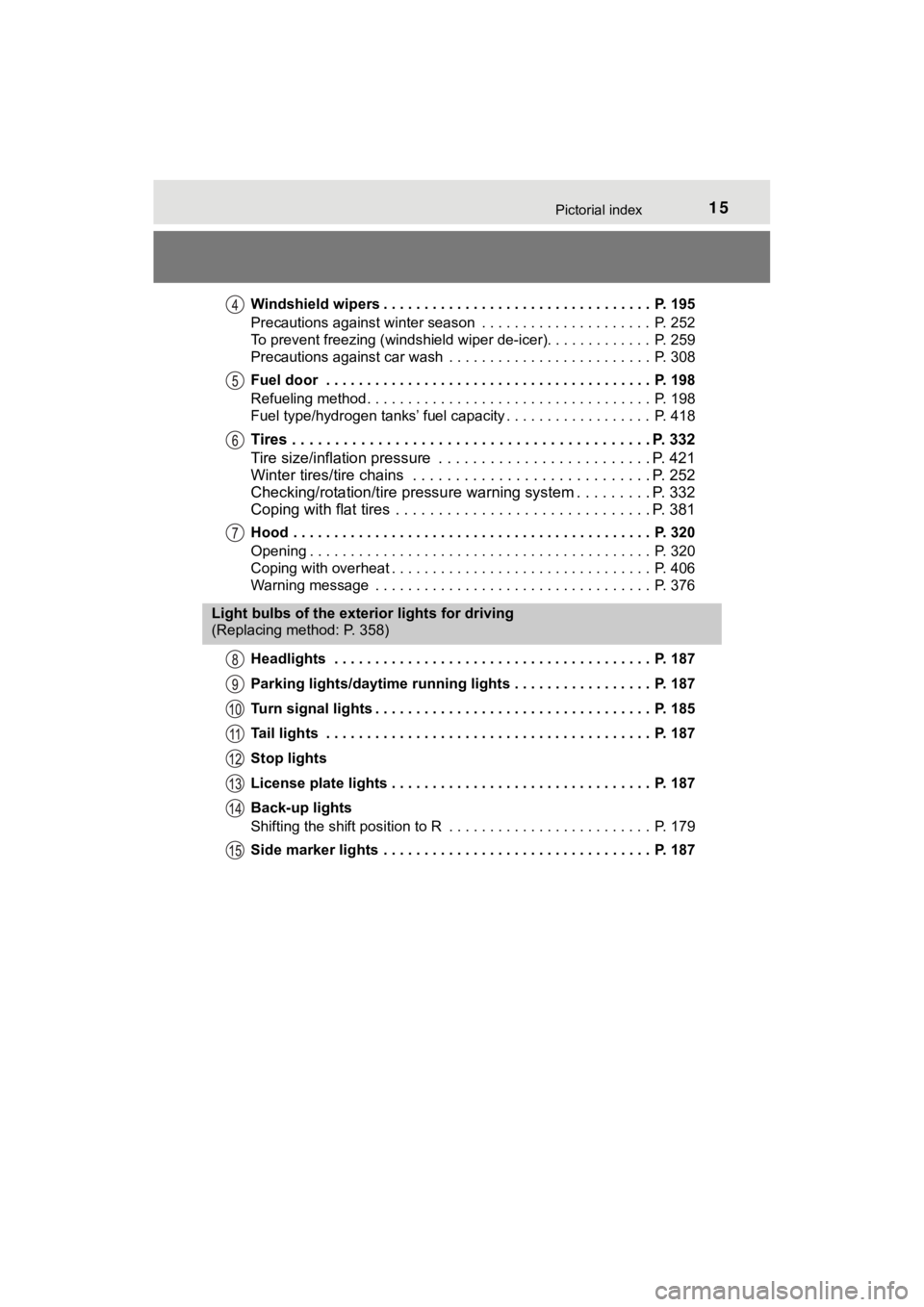
15Pictorial index
MIRAI_OM_USA_OM62025UWindshield wipers . . . . . . . . . . . . . . . . . . . . . . . . . . . . . . . . . P. 195
Precautions against winter season . . . . . . . . . . . . . . . . . . . . . P. 252
To prevent freezing (windshield wiper de-icer). . . . . . . . . . . . . P. 259
Precautions against car wash . . . . . . . . . . . . . . . . . . . . . . . . . P. 308
Fuel door . . . . . . . . . . . . . . . . . . . . . . . . . . . . . . . . . . . . . . . . P. 198
Refueling method . . . . . . . . . . . . . . . . . . . . . . . . . . . . . . . . . . . P. 198
Fuel type/hydrogen tanks’ fuel capacity . . . . . . . . . . . . . . . . . . P. 418
Tires . . . . . . . . . . . . . . . . . . . . . . . . . . . . .
. . . . . . . . . . . . . P. 332
Tire size/inflation pressure . . . . . . . . . . . . . . . . . . . . . . . . . P. 421
Winter tires/tire chains . . . . . . . . . . . . . . . . . . . . . . . . . . . . P. 252
Checking/rotation/tire pressur e warning system . . . . . . . . .P. 332
Coping with flat tires . . . . . . . . . . . . . . . . . . . . . . . . . . . . . . P. 381
Hood . . . . . . . . . . . . . . . . . . . . . . . . . . . . . . . . . . . . . . . . . . . . P. 320
Opening . . . . . . . . . . . . . . . . . . . . . . . . . . . . . . . . . . . . . . . . . . P. 320
Coping with overheat . . . . . . . . . . . . . . . . . . . . . . . . . . . . . . . . P. 406
Warning message . . . . . . . . . . . . . . . . . . . . . . . . . . . . . . . . . . P. 376
Headlights . . . . . . . . . . . . . . . . . . . . . . . . . . . . . . . . . . . . . . . P. 187
Parking lights/daytime running lights . . . . . . . . . . . . . . . . . P. 187
Turn signal lights . . . . . . . . . . . . . . . . . . . . . . . . . . . . . . . . . . P. 185
Tail lights . . . . . . . . . . . . . . . . . . . . . . . . . . . . . . . . . . . . . . . . P. 187
Stop lights
License plate lights . . . . . . . . . . . . . . . . . . . . . . . . . . . . . . . . P. 187
Back-up lights
Shifting the shift position to R . . . . . . . . . . . . . . . . . . . . . . . . . P. 179
Side marker lights . . . . . . . . . . . . . . . . . . . . . . . . . . . . . . . . . P. 187
Light bulbs of the exterior lights for driving
(Replacing method: P. 358)
Page 86 of 464

862. Fuel cell vehicle
MIRAI_OM_USA_OM62025U■
Fuel cell stack
●Depending on the usage environment, the fuel cell power output may
decline over the life of the vehicle. However, this will have almost no effect
on driving performance.
● In the following situations, the fuel cell power output may dec line faster than
normal driving:
• Extended use in areas with high amounts of dust
• Extended use in areas with high levels of sulfur (such as volc anoes or hot
springs).
• Extended use in areas with high concentrations of the following substances:
-Organic solvents, such as paint and thinner
-Amine-related materials such as ammonia
-Chlorinated substances such as salt air and snow-melting agent
However, upon returning to normal environment, the fuel cell po wer output
will recover over time.
• Salt water gets into the air cleaner filter It is recommended to replace the air cleaner filter and clean t he surround-
ing components. Have the vehicle inspected at your Toyota deale r
• The number of times the fuel cell system is started and stoppe d is exces-
sively high
• Extended use in freezing temperatures
■ Hydrogen tanks
●The hydrogen tanks are the high-pressure storage containers that are filled
with compressed hydrogen gas. The vehicle can be refueled at hy drogen
stations.
● The hydrogen tanks have an expiration date. Vehicles with expir ed hydro-
gen tanks must not be driven or refueled until the hydrogen tanks are
replaced. The expiration date is written on the inside of the fuel door. Con-
sult your Toyota dealer.
● When disposing of the hydrogen tanks or the hydrogen tank valve s, consult
your Toyota dealer for details.
Page 95 of 464

952. Fuel cell vehicle
2
Fuel cell system
MIRAI_OM_USA_OM62025U
◆Using Eco drive mode
Using Eco drive mode (P. 181) makes torque generation less
aggressive than normal when stepping on the accelerator pedal,
leading to improvement in fuel economy.
Also, is displayed on the air conditioning screen, indicating
the switch to ECO HEAT/COOL mode ( P. 2 5 8 ) .
◆Air conditioning system on/off
● Turn off the air conditioning system operation switch except
when necessary to help curb fuel consumption.
In summer: When the ambient temperature is high, use the recircu -
lated air mode. This decreases the load on the air con-
ditioning system.
In winter: Avoid excess heating. Use the seat heater to minimize the need for cabin heating ( P. 266).
● By pushing , ECO HEAT/COOL mode is turned on. This
helps curb fuel consumption even with the air conditioning syst em
turned on.
◆Checking tire inflation pressure
Make sure to check the tire inflation pressure frequently. Impr oper
tire inflation pressure can cause poor fuel economy.
Additionally, snow tires have mo re rolling friction and their use on
dry roads lead to poor fuel economy. Use tires that are appropr iate
for the season.
◆Luggage
Avoid carrying unnecessary luggage and unload excess weight in
order avoid poor fuel economy. Installing a large roof rack wil l also
reduce fuel economy.
Page 99 of 464
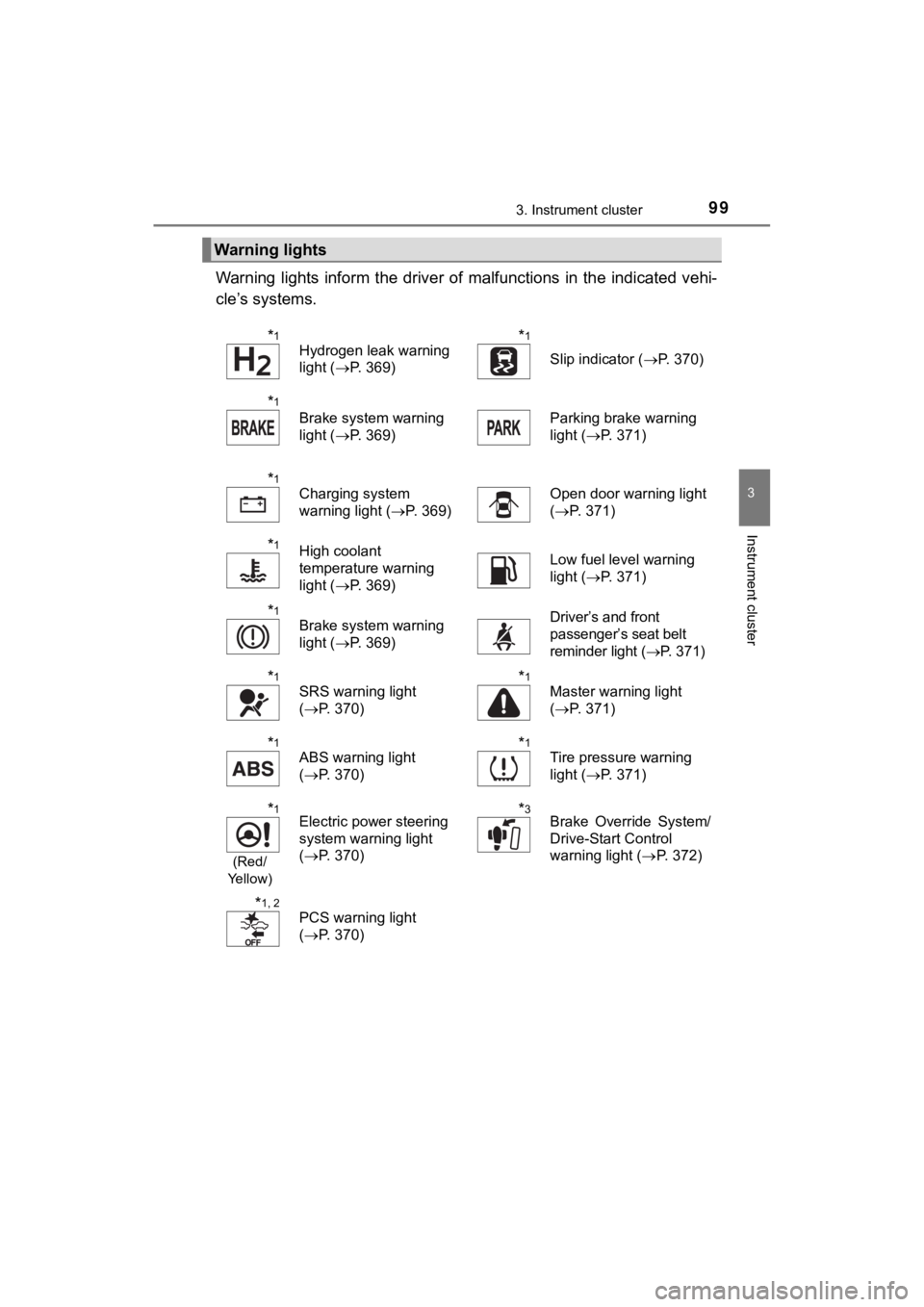
993. Instrument cluster
3
Instrument cluster
MIRAI_OM_USA_OM62025U
Warning lights inform the driver of malfunctions in the indicated vehi-
cle’s systems.
Warning lights
*1
Hydrogen leak warning
light ( P. 369)*1
Slip indicator ( P. 370)
*1
Brake system warning
light (P. 369)Parking brake warning
light (P. 371)
*1
Charging system
warning light ( P. 369)Open door warning light
(P. 371)
*1High coolant
temperature warning
light ( P. 369)Low fuel level warning
light (P. 371)
*1
Brake system warning
light (P. 369)Driver’s and front
passenger’s seat belt
reminder light ( P. 3 7 1 )
*1
SRS warning light
(P. 370)*1
Master warning light
(P. 371)
*1
ABS warning light
(P. 370)*1
Tire pressure warning
light ( P. 371)
*1
(Red/
Ye l l o w )
Electric power steering
system warning light
( P. 370)*3Brake Override System/
Drive-Start Control
warning light ( P. 372)
*1, 2
PCS warning light
(P. 370)
Page 198 of 464
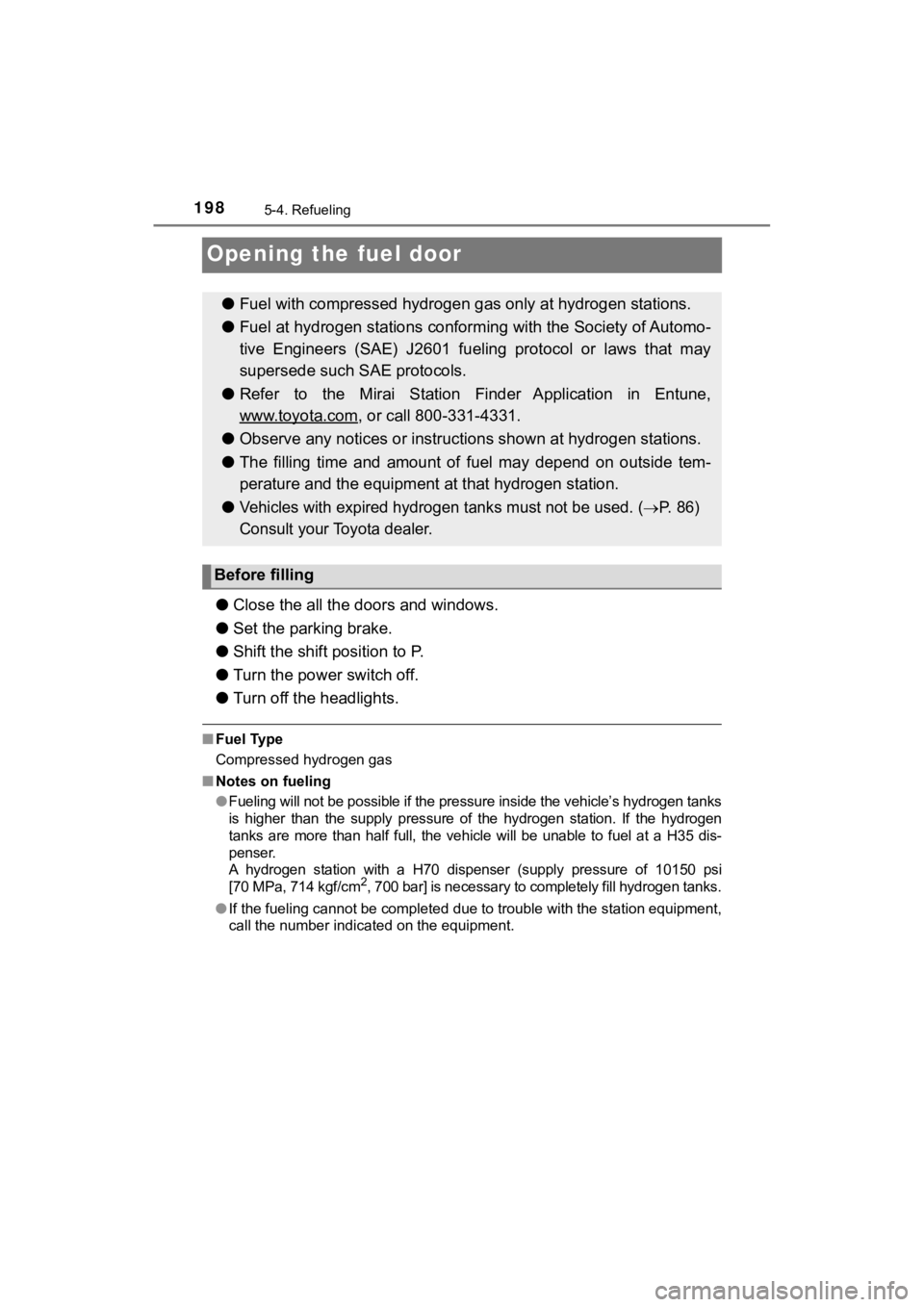
1985-4. Refueling
MIRAI_OM_USA_OM62025U
Opening the fuel door
●Close the all the doors and windows.
● Set the parking brake.
● Shift the shift position to P.
● Turn the power switch off.
● Turn off the headlights.
■Fuel Type
Compressed hydrogen gas
■ Notes on fueling
●Fueling will not be possible if the pressure inside the vehicle ’s hydrogen tanks
is higher than the supply pressure of the hydrogen station. If the hydrogen
tanks are more than half full, the vehicle will be unable to fu el at a H35 dis-
penser.
A hydrogen station with a H70 dispenser (supply pressure of 101 50 psi
[70 MPa, 714 kgf/cm
2, 700 bar] is necessary to completely fill hydrogen tanks.
● If the fueling cannot be completed due to trouble with the station equipment,
call the number indicated on the equipment.
● Fuel with compressed hydrogen g as only at hydrogen stations.
● Fuel at hydrogen stations confor ming with the Society of Automo-
tive Engineers (SAE) J2601 fueling protocol or laws that may
supersede such SAE protocols.
● Refer to the Mirai Station Finder Application in Entune,
www.toyota.com
, or call 800-331-4331.
● Observe any notic es or instructions show n at hydrogen stations.
● The filling time and amount of fuel may depend on outside tem-
perature and the equipment at that hydrogen station.
●
Vehicles with expired hydrogen tanks must not be used. (P. 86)
Consult your Toyota dealer.
Before filling
Page 306 of 464

3067-1. Maintenance and care
MIRAI_OM_USA_OM62025U
Cleaning and protecting the vehicle
exterior
● Working from top to bottom, liberally apply water to the vehicl e
body, wheel wells and underside of the vehicle to remove any di rt
and dust.
● Wash the vehicle body using a sponge or soft cloth, such as a
chamois.
● For hard-to-remove marks, use car wash soap and rinse thoroughl y
with water.
● Wipe away any water.
● Wax the vehicle when the wate rproof coating deteriorates.
If water does not bead on a clean surface, apply wax when the v ehicle
body is cool.
■ Automatic car washes
●Fold the mirrors before washing the vehicle. Start washing from the front of
the vehicle. Make sure to extend the mirrors before driving.
● Brushes used in automatic car washes may scratch the vehicle su rface and
harm your vehicle’s paint.
■ High pressure car washes
●Do not allow the nozzles of the car wash to come within close p roximity of
the windows.
● Before using the car wash, check that the fuel door on your veh icle is closed
properly.
● Turn the power switch off.
Perform the following to protect the vehicle and maintain it in
prime condition:
Page 309 of 464
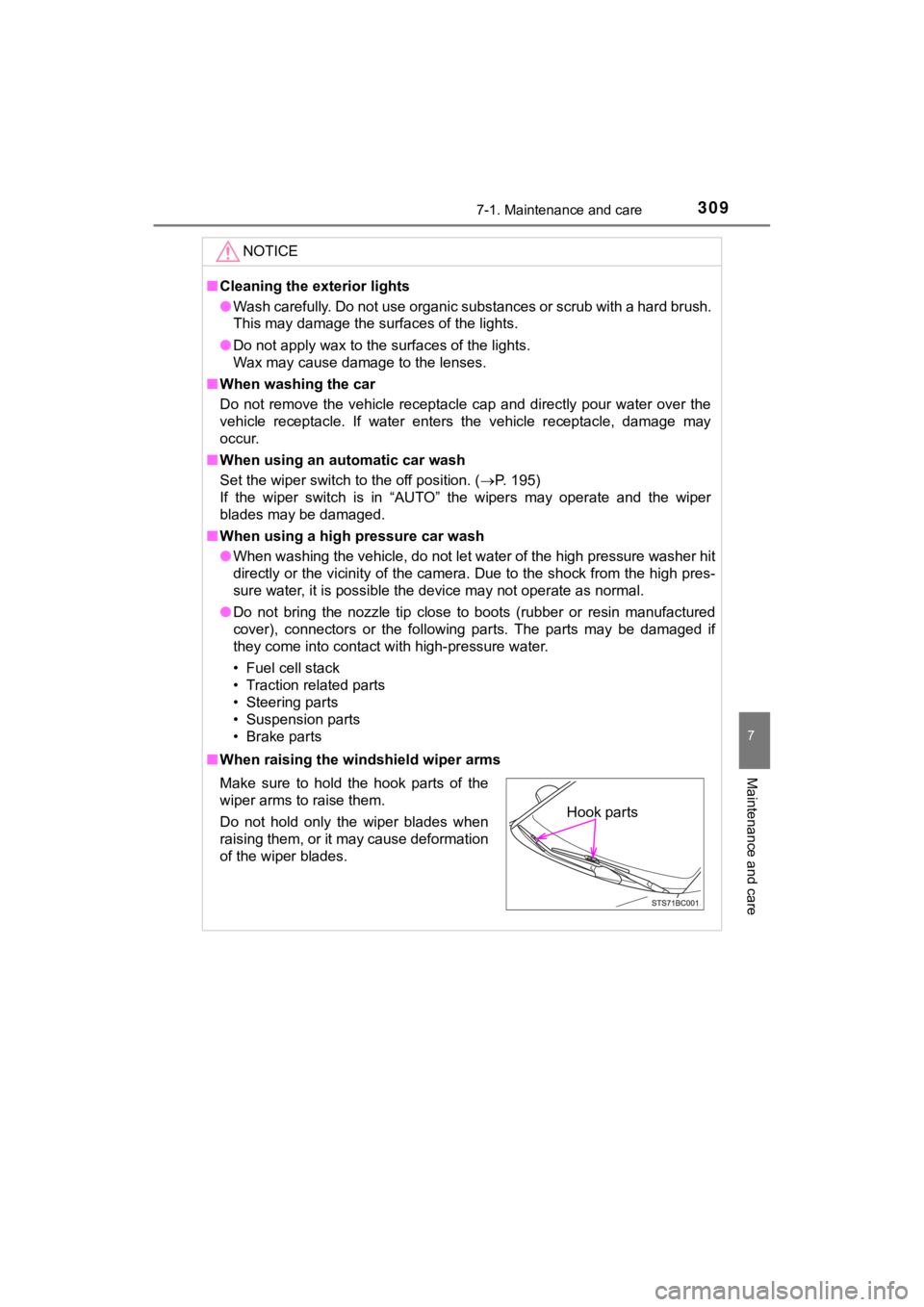
3097-1. Maintenance and care
MIRAI_OM_USA_OM62025U
7
Maintenance and care
NOTICE
■Cleaning the exterior lights
● Wash carefully. Do not use organic substances or scrub with a h ard brush.
This may damage the surfaces of the lights.
● Do not apply wax to the surfaces of the lights.
Wax may cause damage to the lenses.
■ When washing the car
Do not remove the vehicle receptacle cap and directly pour wate r over the
vehicle receptacle. If water enters the vehicle receptacle, dam age may
occur.
■ When using an automatic car wash
Set the wiper switch to the off position. ( P. 195)
If the wiper switch is in “AUTO” the wipers may operate and the wiper
blades may be damaged.
■ When using a high pressure car wash
● When washing the vehicle, do not let water of the high pressure washer hit
directly or the vicinity of the camera. Due to the shock from t he high pres-
sure water, it is possible the device may not operate as normal .
● Do not bring the nozzle tip close to boots (rubber or resin man ufactured
cover), connectors or the following parts. The parts may be dam aged if
they come into contact with high-pressure water.
• Fuel cell stack
• Traction related parts
• Steering parts
• Suspension parts
• Brake parts
■ When raising the windshield wiper arms
Make sure to hold the hook parts of the
wiper arms to raise them.
Do not hold only the wiper blades when
raising them, or it may cause deformation
of the wiper blades.
Hook parts
Page 325 of 464
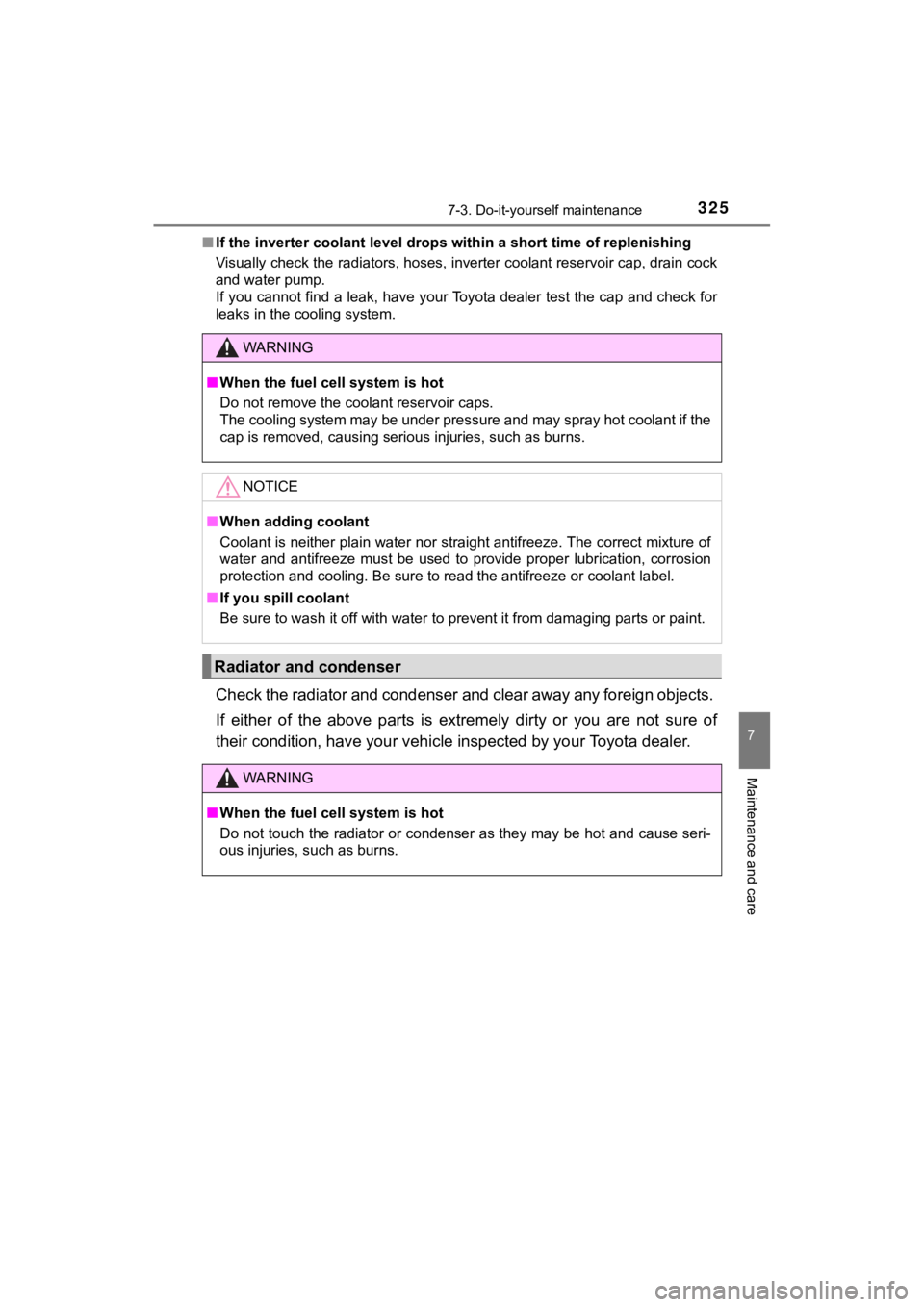
3257-3. Do-it-yourself maintenance
MIRAI_OM_USA_OM62025U
7
Maintenance and care
■If the inverter coolant level drops within a short time of repl enishing
Visually check the radiators, hoses, inverter coolant reservoir cap, drain cock
and water pump.
If you cannot find a leak, have your Toyota dealer test the cap and check for
leaks in the cooling system.
Check the radiator and condenser and clear away any foreign objects.
If either of the above parts is extremely dirty or you are not sure of
their condition, have your vehic le inspected by your Toyota dea ler.
WARNING
■When the fuel cell system is hot
Do not remove the coolant reservoir caps.
The cooling system may be under pressure and may spray hot coolant if the
cap is removed, causing serious injuries, such as burns.
NOTICE
■When adding coolant
Coolant is neither plain water nor straight antifreeze. The cor rect mixture of
water and antifreeze must be used to provide proper lubrication , corrosion
protection and cooling. Be sure to read the antifreeze or coolant label.
■ If you spill coolant
Be sure to wash it off with water to prevent it from damaging p arts or paint.
Radiator and condenser
WARNING
■When the fuel cell system is hot
Do not touch the radiator or condenser as they may be hot and c ause seri-
ous injuries, such as burns.
Page 347 of 464

3477-3. Do-it-yourself maintenance
MIRAI_OM_USA_OM62025U
7
Maintenance and care
Tire valve
Tire pressure gauge
Remove the tire valve cap.
Press the tip of the tire pressure gauge onto the tire valve.
Read the pressure using the gauge gradations.
If the tire inflation pressure is not at the recommended level, adjust
the pressure.
If you add too much air, press the center of the valve to defla te.
After completing the tire inflation pressure measurement and
adjustment, apply soapy water to the valve and check for leakage.
Put the tire valve cap back on.
■Tire inflation pressure check interval
You should check tire inflation p ressure every two weeks, or at least once
a month.
Do not forget to check the spare.
■Effects of incorrect tire inflation pressure
Driving with incorrec t tire inflation pressure may result in th e following:
●Reduced fuel economy
●Reduced driving comfort and poor handling
●Reduced tire life due to wear
●Reduced safety
●Damage to the drivetrain
If a tire needs frequent inflating , have it checked by your Toyota dealer.
Inspection and adjustment procedure
Page 371 of 464
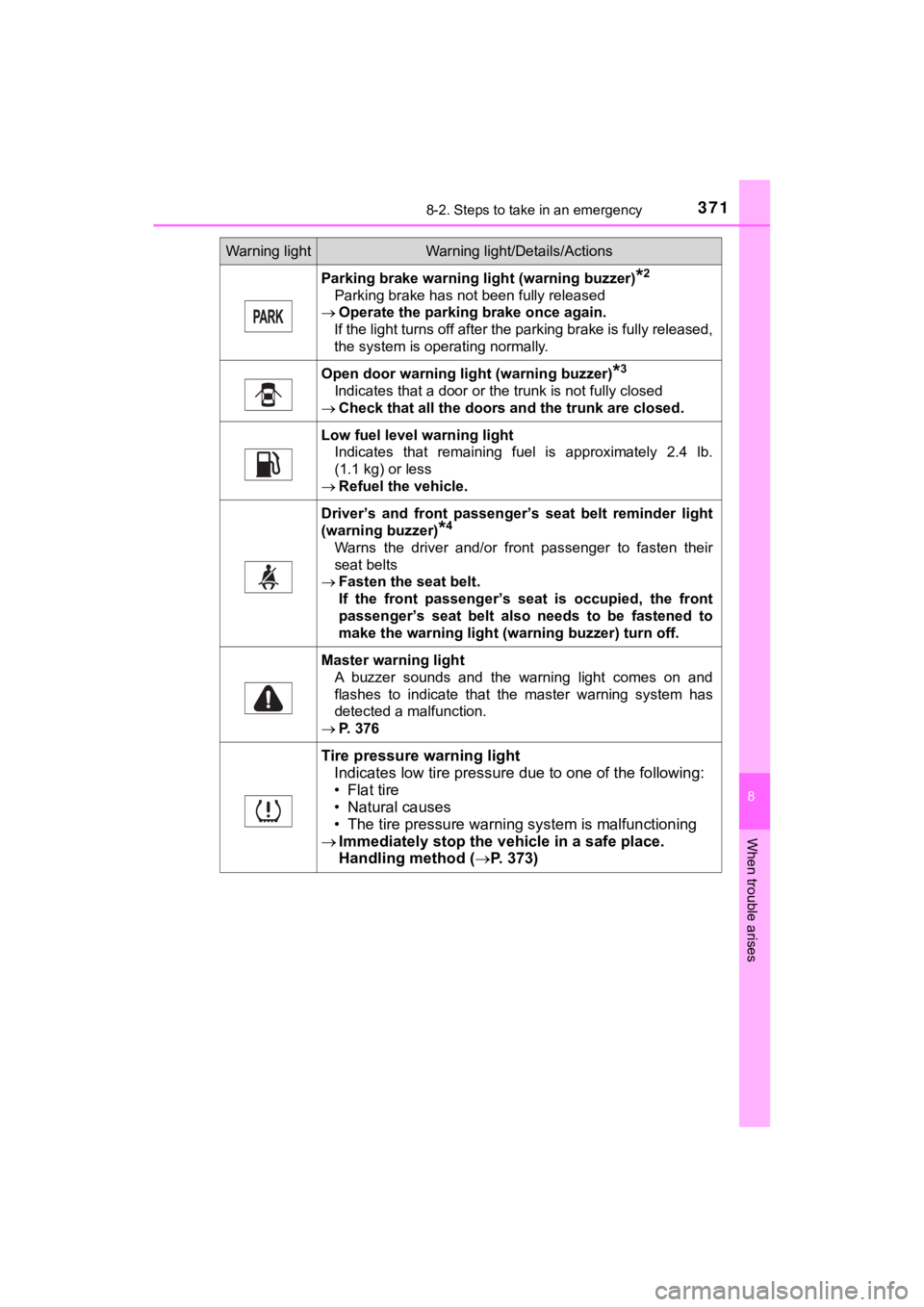
3718-2. Steps to take in an emergency
MIRAI_OM_USA_OM62025U
8
When trouble arises
Parking brake warning light (warning buzzer)*2
Parking brake has not been fully released
Operate the parking brake once again.
If the light turns off after the parking brake is fully release d,
the system is operating normally.
Open door warning light (warning buzzer)*3
Indicates that a door or the trunk is not fully closed
Check that all the doors and the trunk are closed.
Low fuel level warning light
Indicates that remaining fuel is approximately 2.4 lb.
(1.1 kg) or less
Refuel the vehicle.
Driver’s and front passenger’ s seat belt reminder light
(warning buzzer)
*4
Warns the driver and/or front passenger to fasten their
seat belts
Fasten the seat belt.
If the front passenger’s seat is occupied, the front
passenger’s seat belt also needs to be fastened to
make the warning light (warning buzzer) turn off.
Master warning light
A buzzer sounds and the warning light comes on and
flashes to indicate that the master warning system has
detected a malfunction.
P. 376
Tire pressure warning light
Indicates low tire pressure due to one of the following:
• Flat tire
• Natural causes
• The tire pressure warning system is malfunctioning
Immediately stop the veh icle in a safe place.
Handling method ( P. 3 7 3 )
Warning lightWarning light/Details/Actions